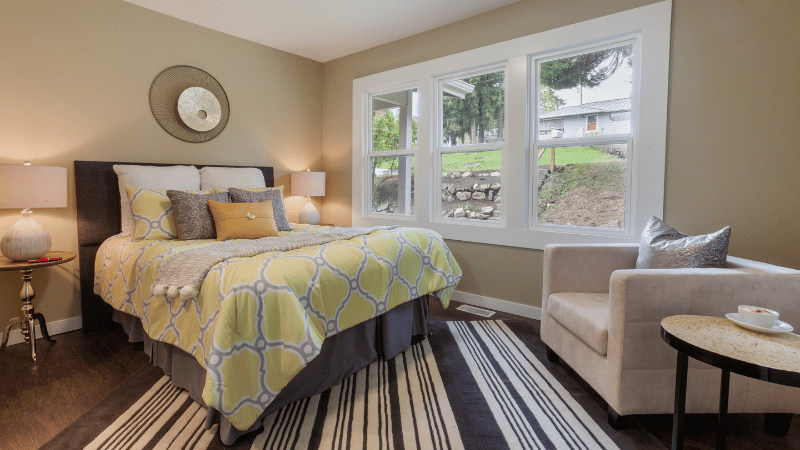There’s a certain magic in a good night’s sleep – the kind that leaves you waking up refreshed, rejuvenated, and ready to conquer the day. As hosts, the secret to providing this magical experience lies in the often-overlooked world of bedding. Today, we unravel the importance of choosing allergy-friendly bedding, exploring how it can transform a mere stay into a restful sanctuary for your guests.
The Power of a Restful Night:
Imagine the joy of sinking into a plush bed, enveloped by soft sheets and fluffy pillows, with not a care in the world. A restful night’s sleep is not just about luxury; it’s about health and well-being. Your choice of bedding can play a pivotal role in ensuring that your guests not only sleep soundly but also wake up feeling their best.
Understanding Allergies:
Allergies, whether to dust mites, pet dander, or certain fabrics, are more common than one might think. For some guests, a seemingly comfortable bed could turn into a nightmare if the bedding materials trigger their allergies. As hosts, it’s our responsibility to create an environment that caters to a diverse range of needs and sensitivities.
Understanding Non-Toxic Bedding:
Non-toxic bedding refers to bed linens and associated products that are free from harmful chemicals and substances. These bedding items are made from materials and manufacturing processes that prioritize health, safety, and environmental sustainability. Here’s a more detailed look at what makes bedding non-toxic:
Key Characteristics of Non-Toxic Bedding
- Chemical-Free: Non-toxic bedding is free from harmful chemicals such as formaldehyde, flame retardants, volatile organic compounds (VOCs), and phthalates. These chemicals are often found in conventional bedding and can off-gas, causing potential health issues and can trigger allergies or sensitives.
- Natural and Organic Materials:
- Organic Cotton: Grown without synthetic pesticides, herbicides, and fertilizers.
- Bamboo: Often produced with fewer chemicals and is naturally hypoallergenic.
- Linen: Made from the flax plant, which generally requires fewer pesticides and fertilizers.
- Wool: Natural and often processed without harsh chemicals.
- Tencel (Lyocell): Made from sustainably sourced wood pulp through a closed-loop process that minimizes chemical use.
- Non-Toxic Dyes and Finishes: Uses natural or low-impact dyes and avoids treatments that contain harmful chemicals.
- Eco-Friendly Production: Manufactured through processes that reduce environmental impact, such as less water usage, renewable energy, and sustainable farming practices.
Important Certifications
- GOTS (Global Organic Textile Standard): Ensures organic status of textiles from harvesting to manufacturing, including social and environmental criteria.
- OEKO-TEX Standard 100: Tests for harmful substances in textiles to ensure safety.
- GreenGuard: Certifies products with low chemical emissions, improving indoor air quality.
- Cradle to Cradle: Assesses products for safety to humans and the environment and encourages continuous improvement.
Hypoallergenic Bedding:
The hero in the realm of allergy-friendly bedding is undoubtedly hypoallergenic materials. Opting for hypoallergenic sheets, pillowcases, and comforters can significantly reduce the presence of allergens, providing a clean and safe haven for your guests. These materials are designed to resist dust mites, mold, and other common allergens, ensuring a peaceful night’s sleep for all.
The Versatility of Cotton:
Cotton, with its breathability and hypoallergenic properties, stands as a timeless champion in the world of bedding. Its natural fibers allow air to circulate, preventing the accumulation of moisture that can foster allergens. Additionally, cotton is easily washable, making it a practical choice for maintaining cleanliness and reducing the risk of allergies.
Microfiber Marvel:
For those seeking an alternative to traditional fabrics, microfiber emerges as a marvel in the realm of bedding. Microfiber sheets are not only silky-soft but also resistant to allergens. The tightly woven fibers create a barrier against dust mites and other irritants, making them an excellent choice for guests with sensitivities.
Bamboo Bedding:
Embrace the eco-friendly allure of bamboo bedding. Bamboo fibers are naturally hypoallergenic, antimicrobial, and resistant to dust mites. Beyond their allergy-friendly qualities, bamboo sheets offer a luxurious feel, providing your guests with an exquisite touch of nature.
Encasing Pillows and Mattresses:
Taking allergy prevention a step further, consider investing in allergen-proof pillow and mattress encasements. These protective covers act as barriers, preventing allergens from infiltrating the sleeping area. They are particularly beneficial for guests with severe allergies or respiratory conditions, offering an extra layer of assurance for a restful night’s sleep.
Regular Cleaning:
Maintaining allergy-friendly bedding is not just about the initial choice but also about regular cleaning. Washing sheets, pillowcases, and comforters at the recommended intervals helps eliminate any accumulated allergens, ensuring that your guests’ sleep environment remains pristine and inviting.
Communication is Key:
Enhance the guest experience by fostering open communication about bedding preferences. Inquire about any specific allergies or sensitivities your guests may have before their arrival, demonstrating your commitment to their well-being. This small gesture can go a long way in making your guests feel cared for and valued. The art of hosting extends beyond providing shelter; it involves creating a sanctuary where guests can truly unwind and rejuvenate. In the realm of bedding, the choices you make can impact the quality of sleep and overall well-being of those who grace your home. By embracing allergy-friendly bedding options, you not only prioritize the comfort of your guests but also contribute to the creation of a restful haven. So, as you prepare to welcome guests into your abode, let your bedding choices be a testament to your commitment to their tranquil and blissful night’s sleep.

